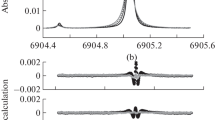Abstract
Broadening coefficient of sulfur dioxide lines by carbon dioxide are calculated at room temperature for the ν1 + ν3 band with the rotational quantum numbers J and Ka varying in the ranges up to 100 and up to 20, respectively. Parameters of the semi-empirical method are determined from the analysis of experimental data. The broadening coefficients computed are in a good agreement with the literature data.



Similar content being viewed by others
REFERENCES
B. Bezard, C. Bergh, B. Fegley, J.-P. Maillard, D. Crisp, T. Owen, J. B. Pollack, and D. Grinspoon, “The abundance of sulfur dioxide below the clouds of Venus,” Geophys. Rev. Lett. 20 (15), 1587–1590 (1993).
E. Marcq, J.-L. Bertaux, F. Montmessin, and D. Belyaev, “Variations of sulphur dioxide at the cloud top of Venus’s dynamic atmosphere,” Nat. Geosci. 6 (1), 25–28 (2013).
L. Roth, J. Boissier, A. Moullet, A. Sanchez-Monge, K. Kleer, M. Yoneda, and R. Hikida, “An attempt to detect transient changes in Io’s SO2 and NaCl atmosphere,” Icarus 350, 113925 (2020).
A. Khayat, G. Villanueva, M. Mumma, and A. Tokunaga, “A search for and above Tharsis and Syrtis volcanic districts on Mars using ground-based high-resolution submillimeter spectroscopy,” Icarus 253, 130–141 (2015).
E. Herbst and E. F. Dishoeck, “Complex organic interstellar molecules,” Ann. Rev. Astron. Astrophys. 47, 427–480 (2009).
Chandra S. Krishnaji, “Molecular interaction and linewidth of the asymmetric molecule SO2. II. SO2–CO2 collisions,” J. Chem. Phys. 38 (4), 1019–1021 (1963).
G. Ceselin, N. Tasinato, C. Puzzarini, A. P. Charmet, P. Stoppa, and S. Giorgianni, “CO2-, He- and H2‑broadening coefficients of SO2 for ν1 band and ground state transitions for astrophysical applications,” J. Quant. Spectrosc. Radiat. Transfer 203, 367–376 (2017).
Yu. G. Borkov, O. M. Lyulin, T. M. Petrova, A. M. Solodov, A. A. Solodov, V. M. Deichuli, and V. I. Perevalov, “CO2-broadening and shift coefficients of sulfur dioxide near 4 μm,” J. Quant. Spectrosc. Radiat. Transfer 225, 119–124 (2019).
A. S. Dudaryonok and N. N. Lavrentieva, “Theoretical estimation of SO2 line broadening coefficients induced by carbon dioxide in the 150–300 K temperature range,” J. Quant. Spectrosc. Radiat. Transfer 219, 360–365 (2018).
A. S. Dudaryonok, T. A. Nevzorova, N. A. Lavrentiev, and N. N. Lavrentieva, “Calculation of SO2–CO2 line broadening coefficients,” Proc. SPIE—Int. Soc. Opt. Eng. 12341 (2022).
J. S. Wilzewski, I. Gordon, R. V. Kochanov, C. Hill, and L. S. Rothman, “H2, He, and CO2 line-broadening coefficients, pressure shifts and temperature-dependence exponents for the HITRAN database. Part 1: SO2, NH3, HF, HCl, OCS and C2H2,” J. Quant. Spectrosc. Radiat. Transfer 168, 193–206 (2016).
I. E. Gordon, L. S. Rothman, R. J. Hargreaves, R. Hashemi, E. V. Karlovets, F. M. Skinner, E. K. Conway, C. Hill, R. V. Kochanov, Y. Tan, P. Wcislo, A. A. Finenko, K. Nelson, P. F. Bernath, M. Birk, V. Boudon, A. Campargue, K. V. Chance, A. Coustenis, B. J. Drouin, J.-M. Flaud, R. R. Gamache, J. T. Hodges, D. Jacquemart, E. J. Mlawer, A. V. Nikitin, V. I. Perevalov, M. Rotger, J. Tennyson, G. C. Toon, H. Tran, V. G. Tyuterev, E. M. Adkins, A. Baker, A. Barbe, E. Canew, A. G. Csaszar, A. Dudaryonok, O. Egorov, A. J. Fleisher, H. Fleurbaey, A. Foltynowicz, T. Furtenbacher, J. J. Harrison, J.-M. Hartmann, V.-M. Horneman, X. Huang, T. Karman, J. Karns, S. Kassi, I. Kleiner, V. Kofman, F. Kwabia-Tchana, N. N. Lavrentieva, T. J. Lee, D. A. Long, A. A. Lukashevskaya, O. M. Lyulin, V. Yu. Makhnev, W. Matt, S. T. Massie, M. Melosso, S. N. Mikhailenko, D. Mondelain, H. S. P. Muller, O. V. Naumenko, A. Perrin, O. L. Polyansky, E. Raddaoui, P. L. Raston, Z. D. Reed, M. Rey, C. Richard, R. Tobias, I. Sadiek, D. W. Schwenke, E. Starikova, K. Sung, F. Tamassia, S. A. Tashkun, J. V. Auwera, I. A. Vasilenko, A. A. Vigasin, G. L. Villanueva, B. Vispoel, G. Wagner, A. Yachmenev, and S. N. Yurchenko, “The HITRAN2020 molecular spectroscopic database,” J. Quant. Spectrosc. Radiat. Transfer 277 (1), 107949 (2022).
H. S. P. Muller and S. Brumken, “Accurate rotational spectroscopy of sulfur dioxide, SO2, in its ground vibrational and first excited bending states, ν2 = 0, 1, up to 2 THz,” J. Mol. Spectrosc. 232 (2), 213–222 (2005).
A. D. Bykov, N. N. Lavrentieva, and L. N. Sinitsa, “Semi-empiric approach of the calculation of H2O and CO2 line broadening and shifting,” Mol. Phys. 102 (14-15), 1653–1658 (2004).
W. J. Lafferty, A. S. Pine, G. Hilpert, R. L. Sams, J.‑M. Flaud, “The ν1 + ν3 and 2ν1 + ν3 band systems of SO2: Line positions and intensities,” J. Mol. Spectrosc. 176 (2), 280–286 (1996).
A. A. Radtsig and B. M. Smirnov, Handbook of Atomic and Molecular Physics (Atomizdat, Moscow, 1980) [in Russian].
C. G. Gray and K. E. Gubbins, Theory of Molecular Fluids, Vol. 1, Fundamentals (Clarendon Press, Oxford, 1984).
C. Graham, J. Pierrus, and R. E. Raab, “Measurement of the electric quadrupole moments of CO2, CO and N2,” Mol. Phys. 67 (4), 939–955 (1989).
A. D. Bykov, N. N. Lavrent’eva, and L. N. Sinitsa, “The H2O line shifts induced by nitrogen, oxygen, and air pressure within the impact theory by Anderson,” Atmos. Ocean. Opt. 12 (10), 919–927 (1999).
Funding
The work was supported by the Ministry of Science and Higher Education of the Russian Federation (V.E. Zuev Institute of Atmospheric Optics, Siberian Branch, Russian Academy of Sciences).
Author information
Authors and Affiliations
Corresponding authors
Ethics declarations
The authors declare that they have no conflicts of interest.
Additional information
Translated by O. Ponomareva
Supplementary Information
Rights and permissions
About this article
Cite this article
Nevzorova, T.A., Dudaryonok, A.S., Lavrentiev, N.A. et al. Calculation of Broadening Coefficients of Sulfur Dioxide Lines by Carbon Dioxide in the ν1 + ν3 A-type Band at Room Temperature. Atmos Ocean Opt 36, 287–292 (2023). https://doi.org/10.1134/S1024856023040127
Received:
Revised:
Accepted:
Published:
Issue Date:
DOI: https://doi.org/10.1134/S1024856023040127



